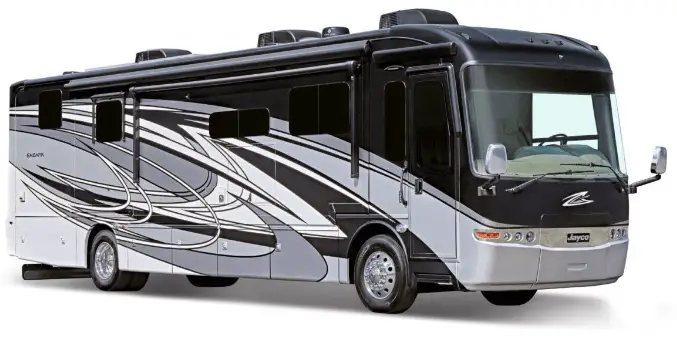Jayco Embark 2023 Weighing Your Motor Home User Manual
Weighing Your Motor Home
When your motor home is loaded you should have it weighed. The actual weight of the motor home, passengers, all options, liquids, the hitch weight of your towed vehicle and your personal cargo is important for you to know so you do not exceed the GVWR. There are two important factors when loading your motor home, total weight and balance. It is imperative that you verify compliance within all applicable weight ratings. Overloading your motor home will void the Limited Warranty and the warranties of many component part manufacturers. Periodically weigh your motor home at a public scale to determine proper load distribution. To obtain the side-to-side weights, there needs to be enough space on either side of the scale to accommodate the motor home being partially off the scale.
Different types or scales may require different procedures when weighing the motor home. The motor home must remain as level as possible on the scale (even if an axle is not physically on the scale). To obtain the side-to-side weights, make sure there is enough space on either side of the scale to accommodate the motor home being partially off the scale. If a boat, trailer or other vehicle is being towed, it should be weighed separately. Combine this weight with the motor home’s Gross Vehicle Weight (GVW) to ensure the total combined weight does not exceed the GCWR. Once actual weights are obtained, compare them to the Weight Information Label weight ratings to ensure you are below the posted minimum ratings. If there is a difference in the weights on one side of the vehicle as compared to weights on the other side, components (tires, wheels, brakes, springs, etc.) on the heavier side may be overloaded, although the total axle load is within the GAWR.
Caution
It is important to redistribute the load to avoid component failure as well as to improve the handling characteristics of the vehicle.
Warning
Dump the gray and black water holding tanks before traveling to avoid carrying unnecessary weight. Full tanks can affect your fuel consumption, and de-pending on tank location can affect your vehicle handling characteristics. If you cannot immediately empty your holding tanks, reduce your vehicle speed until you reach a dumping station.
Vehicle Operation
Your motor home will travel safely and comfortably at highway speed limits. However, it will take longer than a passenger automobile to reach that speed. Allow more time to go around the vehicle you are passing. Avoid situations that might require sudden momentum changes as the length of the motor home affects your ability to quickly cut back into traffic. Swerves and sharp turns, especially at high speeds, could result in loss of control of the motor home.
The motor home has a longer turning radius. When turning, check the road clearance and be aware of others, especially if towing a vehicle behind your motor home.
Adverse weather conditions and extremes in terrain may affect the performance and handling of your vehicle. Do not operate the cruise control on icy or extremely wet roads, gravel roads, winding roads, heavy traffic, or any other traffic situation where a constant speed cannot be maintained. Use care when accelerating or decelerating on a slippery surface. Abrupt speed changes can cause skidding and loss of control.
NOTE:
CALIFORNIA TIRE CHAIN NOTICE: YOUR MOTOR HOME MAY NOT BE OPERATED WITH TIRE CHAINS
Braking and Stopping
Even though your motor home is equipped with brakes designed for its Gross Vehicle Weight Rating (GVWR) we suggest you practice stopping away from traffic until you become accustomed to your motor home’s stopping distance. Your motor home is equipped with a third brake light that activates when the brakes are engaged.
When descending a long hill, shift the transmission into a lower gear and engage the auxiliary engine braking. If your motor home is equipped with an auxiliary engine brake, engagement is activated by a switch on the driver’s console. See the chassis owner’s manual for additional information. The transmission and engine will help in controlling downhill speed and can lengthen brake life. The distance required to stop the motor home is greater than automobiles. Driving through water deep enough to wet the brakes may affect the stopping distance or cause the vehicle to pull to one side. Check the motor home’s brake operation in a safe area to be sure they have not been affected. Never operate any vehicle if a difference in braking efficiency is noticeable.
Warning
Your motor home chassis braking system is rated for operation at GVWR, not GCWR.
Parking Brake
The parking brake should be engaged when the motor home is parked. Never drive your motor home with the parking brake engaged as this will reduce braking effectiveness and cause excessive driveline wear. Refer to your Chassis guide for more information on the parking brake.
[amalinkspro_table id=”32452″ new-window=”on” nofollow=”on” addtocart=”off” /]
Reference Links
View Full User Guide: Jayco Embark 2023 User Manual
Download Manuals: https://www.jayco.com/manuals


